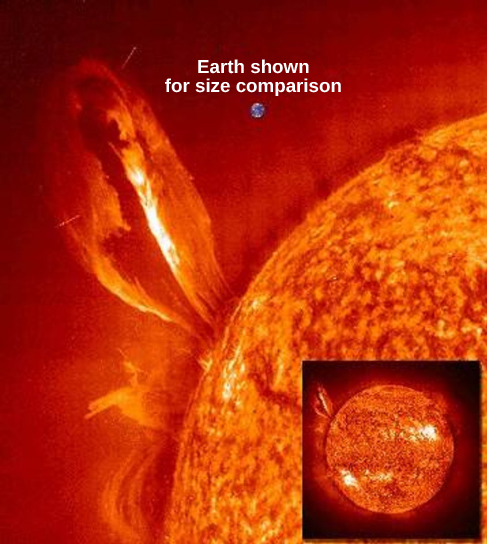| << Chapter < Page | Chapter >> Page > |
By the end of this section, you will be able to:
The Sun , like all stars, is an enormous ball of extremely hot, largely ionized gas, shining under its own power. And we do mean enormous. The Sun could fit 109 Earths side-by-side across its diameter, and it has enough volume (takes up enough space) to hold about 1.3 million Earths.
The Sun does not have a solid surface or continents like Earth, nor does it have a solid core ( [link] ). However, it does have a lot of structure and can be discussed as a series of layers, not unlike an onion. In this section, we describe the huge changes that occur in the Sun’s extensive interior and atmosphere, and the dynamic and violent eruptions that occur daily in its outer layers.

Some of the basic characteristics of the Sun are listed in [link] . Although some of the terms in that table may be unfamiliar to you right now, you will get to know them as you read further.
| Characteristics of the Sun | ||
|---|---|---|
| Characteristic | How Found | Value |
| Mean distance | Radar reflection from planets | 1 AU (149,597,892 km) |
| Maximum distance from Earth | 1.521 × 10 8 km | |
| Minimum distance from Earth | 1.471 × 10 8 km | |
| Mass | Orbit of Earth | 333,400 Earth masses (1.99 × 10 30 kg) |
| Mean angular diameter | Direct measure | 31´59´´.3 |
| Diameter of photosphere | Angular size and distance | 109.3 × Earth diameter (1.39 × 10 6 km) |
| Mean density | Mass/volume | 1.41 g/cm
3
(1400 kg/m 3 ) |
| Gravitational acceleration at photosphere (surface gravity) | GM/R 2 | 27.9 × Earth surface gravity = 273 m/s 2 |
| Solar constant | Instrument sensitive to radiation at all wavelengths | 1370 W/m 2 |
| Luminosity | Solar constant × area of spherical surface 1 AU in radius | 3.8 × 10 26 W |
| Spectral class | Spectrum | G2V |
| Effective temperature | Derived from luminosity and radius of the Sun | 5800 K |
| Rotation period at equator | Sunspots and Doppler shift in spectra taken at the edge of the Sun | 24 days 16 hours |
| Inclination of equator to ecliptic | Motions of sunspots | 7°10´.5 |
Let’s begin by asking what the solar atmosphere is made of. As explained in Radiation and Spectra , we can use a star’s absorption line spectrum to determine what elements are present. It turns out that the Sun contains the same elements as Earth but not in the same proportions. About 73% of the Sun’s mass is hydrogen, and another 25% is helium. All the other chemical elements (including those we know and love in our own bodies, such as carbon, oxygen, and nitrogen) make up only 2% of our star. The 10 most abundant gases in the Sun’s visible surface layer are listed in [link] . Examine that table and notice that the composition of the Sun’s outer layer is very different from Earth’s crust, where we live. (In our planet’s crust, the three most abundant elements are oxygen, silicon, and aluminum.) Although not like our planet’s, the makeup of the Sun is quite typical of stars in general.

Notification Switch
Would you like to follow the 'Astronomy' conversation and receive update notifications?